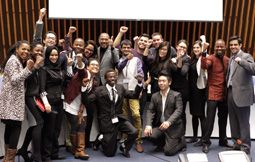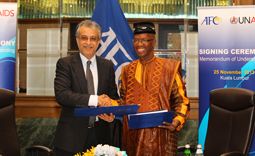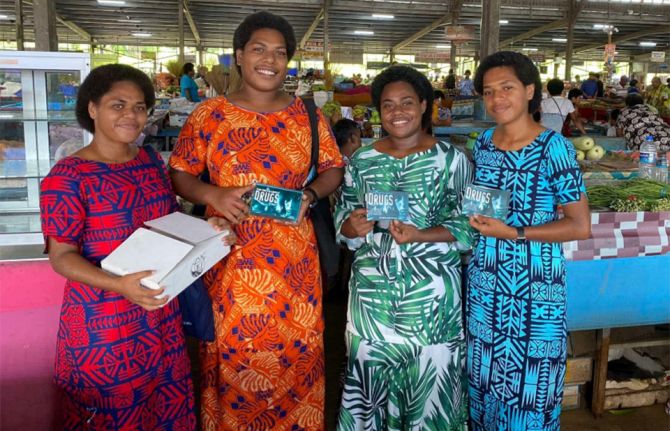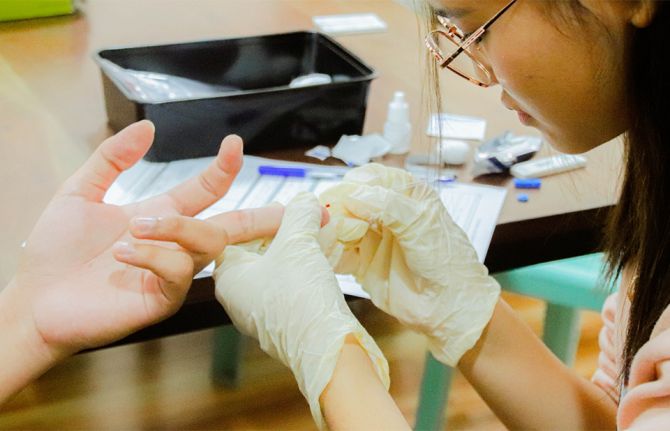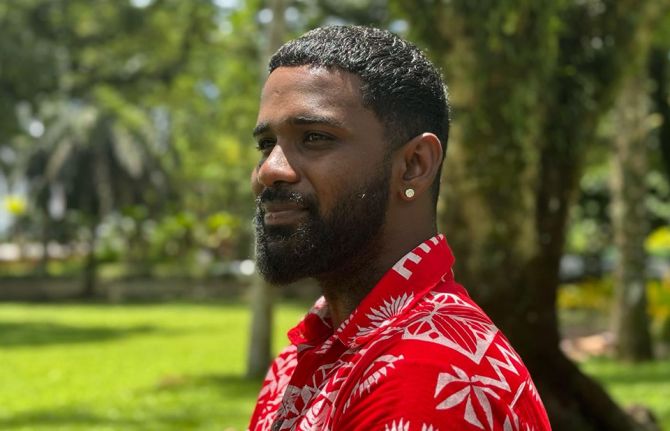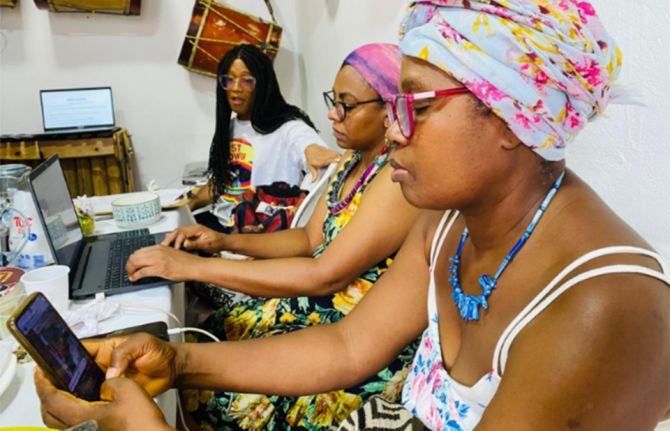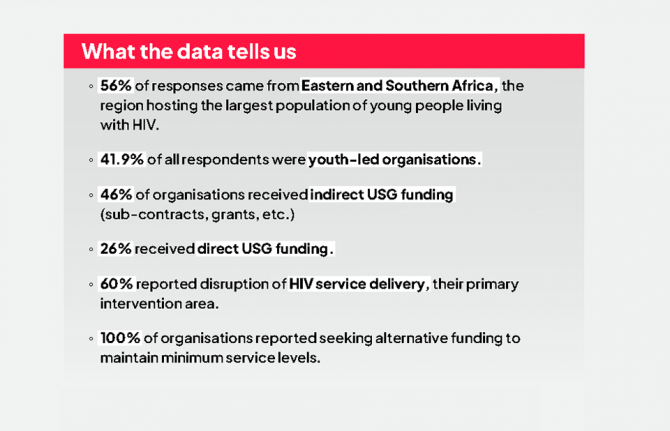
Feature Story
UNICEF: MDGs for children can be reached faster with focus on most disadvantaged
07 September 2010
07 September 2010 07 September 2010UNICEF highlights alarming evidence of growing disparities in the lives of children across a wide range of indicators

Millions of lives can be saved globally by investing first in the most disadvantaged children, young people and communities, according to new UNICEF data released today. Such an approach would also address the widening disparities that are accompanying progress toward the Millennium Development Goals (MDGs).
The new findings are presented in two publications: Narrowing the Gaps to Meet the Goals and Progress for Children: Achieving the MDGs with Equity, UNICEF’s flagship report.
While great progress is being made in international efforts to meet the MDGs, much more needs to be done over the next five years, UNICEF argues. The nature of the global HIV epidemic tellingly highlights the disparities between the richest and poorest within and across nations, and the consequences of these disparities. For example 20 countries—nearly half of them in sub-Saharan Africa—contribute approximately 90% of the global gap in reaching women with drugs to prevent HIV transmission to their babies according the WHO, UNICEF and UNAIDS report Towards Universal Access: Scaling up priority HIV/AIDS interventions in the health sector (2009).
Our findings challenge the traditional thinking that focusing on the poorest and most disadvantaged children is not cost-effective.
Anthony Lake, Executive Director of UNICEF
Additionally, though significant progress has been made in providing antiretroviral therapy to children who need it, almost two thirds of these children in low- and middle- income countries still lack access to treatment. AIDS remains the main cause of death among under-fives in high-prevalence countries [countries have an HIV prevalence of 10% or more].
Part of Millennium Development Goal number 6 is to have halted and begun to reverse the spread of HIV by 2015. According to UNICEF, for this target to be met priority must also be given to reaching young people, particularly adolescent girls in sub-Saharan Africa. The vast majority of new HIV infections still occur in the region, which accounts for more than 80 percent of young people aged 15-24 living with HIV.
The report states that because national burdens of disease, ill health and illiteracy are concentrated in the most impoverished child populations, providing these children with essential services can greatly accelerate progress towards the MDGs and reduce disparities within nations
“Our findings challenge the traditional thinking that focusing on the poorest and most disadvantaged children is not cost-effective,” said Anthony Lake, UNICEF’s Executive Director. “An equity-focused strategy will yield not only a moral victory – right in principle – but an even more exciting one: right in practice.”
Right Hand Content
UNAIDS Cosponsors:
United Nations Children’s Fund (UNICEF)
Multimedia:
Video footage and high resolution images will be available at:
www.thenewsmarket.com/unicef
Feature stories:
Data shows progress needed on HIV testing and treatment for children and mothers(30 November 2009)
No African child should be born with HIV by 2015 (20 April 2010)
Contact:
UNICEF Media, New York
Kate Donovan
tel. +1 212 326 7452
kdonovan@unicef.org
UNICEF Media, New York
Janine Kandel
tel. + 1 212 326 7684
jkandel@unicef.org
Publications:
Full report: 'Progress for Children: Achieving the MDGs with Equity' (pdf, 3.89 Mb)
Study: ‘Narrowing the Gaps to Meet the Goals’ (pdf, 229 Kb)
Related

Feature Story
UNAIDS Executive Director commends Japan’s commitment to AIDS and the Global Fund
03 September 2010
03 September 2010 03 September 2010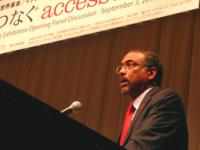
UNAIDS Executive Director Michel Sidibé addresses the “Access to Life” photo exhibition in Tokyo. 3 September, 2010. Credit: UNAIDS
UNAIDS Executive Director Michel Sidibé congratulated the Japanese Prime Minister Naoto Kan on his country’s generosity to the AIDS response. Japan has invested more than US$ 1 billion in HIV assistance to low-and middle-income countries since 2002. Japan is a leading donor of the Global Fund to Fight AIDS, Tuberculosis and Malaria, which was first conceived at the 2000 G8 summit in Okinawa.
In his address at the opening of the “Access to Life” photo exhibition in Tokyo, Prime Minister Kan emphasized the commitment of the Government of Japan to support the global AIDS response at the upcoming Summit for the Millennium Development Goals.
“Infectious diseases are a threat to human security, but progress in treatment has enabled people living with HIV to lead normal lives,” said Prime Minister Kan. “At the MDG Summit, I will do my best to present strong support for the global AIDS response through our support for the Global Fund.”
At the MDG Summit, I will do my best to present strong support for the global AIDS response through our support for the Global Fund.
Naoto Kan, Japanese Prime Minister
“Japan’s exemplary commitment to the AIDS response is saving millions of lives around the world,” said Mr Sidibé. “The country’s attention to human security and the value of human life enabled the G8 to keep HIV and global health high on the global agenda.”
The photo exhibition was jointly produced by the Global Fund and Magnum Photos. The Fund’s Executive Director Michel Kazatchkine also attended the launch, which comes just weeks before a crucial replenishment meeting in New York.
“As our fourth largest donor, Japan has been such a strong supporter of the Global Fund” said Mr Kazatchkine. “With the support of the people of Japan, more than five million people now access AIDS treatment in developing countries.”
Japan’s exemplary commitment to the AIDS response is saving millions of lives around the world.
Michel Sidibé, UNAIDS Executive Director
The meeting with the Prime Minister came on the last day of Mr Sidibé’s first official visit to Japan which included discussions with key Japanese partners in government, public health, civil society and the private sector. In meetings with the Vice Minister of Health, Labour and Welfare, Hiroyuki Nagahama, and senior officials from the Ministry of Foreign Affairs, he encouraged Japan to use its global influence to keep HIV high on the international agenda. A discussion with business leaders focused on how the Japanese private sector has enhanced Japan’s contribution to the AIDS response. Mr Sidibé’s also met with Kiyoshi Kodera, the Vice-President of JICA to discuss opportunities to strengthen ties between JICA and UNAIDS. He held another meeting with Koichiro Matsuura, the former Director General of UNESCO, whose leadership was instrumental in supporting the first international guidelines for HIV sexuality education among young people.
Mr Sidibé paid a courtesy visit to Japan Football Association, that endorsed UNAIDS’ campaign, “Give AIDS the red card” and prevent mother to child HIV transmission. The President of the Japan Football Association, Junji Ogura expressed Japan’s interest in using football to raise public awareness on HIV.
The trip included an impromptu meeting with the Spanish Prime Minister José Luis Rodriguez Zapatero, who was in Japan on an official state visit. Prime Minister Zapatero said his country will continue to be very supportive of the global AIDS response.
In a public address at Tokyo University, Mr Sidibé urged Tokyo to become the first G8 capital to reach UNAIDS’ bold target of zero new HIV infections by 2015. Japan has a low national HIV prevalence rate of 0.01-0.02%.
Mr Sidibé paid a site visit to the MSM Community Center AKTA which is located in the heart of Tokyo’s famous Shinjuku district. This night district houses one of the world’s highest concentration of gay bars. The community centre run by the Japanese non-profit Rainbow Ring provides information on safe sex, peer counseling and HIV testing. While Japan’s HIV prevalence remains low, new HIV cases among MSM have been increasing.
Right Hand Content

Feature Story
‘Investments in AIDS must be maintained’: UNAIDS Executive Director at end of Australia visit
31 August 2010
31 August 2010 31 August 2010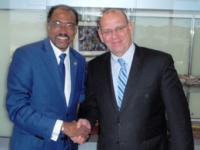
UNAIDS Executive Director Michel Sidibé and Director-General of Australia’s AID Program (AusAID) Peter Baxter in Canberra. Credit: Australian Department of Health and Ageing
Concluding his first official visit to Australia, UNAIDS Executive Director Michel Sidibé stressed the need for the international community to mobilize an additional US $10 billion to meet country-set targets for universal access to HIV prevention, treatment, care and support.
Just weeks before the upcoming replenishment meeting of The Global Fund to Fight AIDS, Tuberculosis and Malaria, Mr Sidibé discussed sustaining and enhancing investments in AIDS with the Director-General of Australia’s AID Program (AusAID) Peter Baxter in the capital Canberra.
“There are currently 10 million people living with HIV who are waiting for life-saving treatment. Unless we close the funding gap, millions of people will be turned away from the promise of universal access,” said Mr. Sidibé during the bilateral.
The Executive Director thanked Mr. Baxter for AusAID’s support to the HIV response, particularly in the Asia-Pacific region, and its recent commitment to increase funding to UNAIDS by almost US $900 000. However, he also expressed his concerns that after steady and significant increases in HIV investments, other donors might for the first time flat-line or even reduce funding.
In Canberra, Mr. Sidibé also met with the Secretary of the Department of Health and Ageing, Jane Halton, and the Deputy Director-General of the Office of National Assessments, Bruce Miller.
Mr Sidibé’s five-day trip to Australia began in Sydney at the Lowy Institute for International Policy where he spoke on the state of the epidemic and imperatives for reshaping the global AIDS response. In Sydney, he visited the renowned medically supervised injecting centre in Kings Cross, the only such facility in the Southern Hemisphere. He commended the facility’s work, calling it a ''pragmatic, cost-effective'' model to halt HIV transmission and prevent illness and death among the most vulnerable intravenous drug users in New South Wales.
Mr. Sidibé was presented with an award from a coalition of organizations involved in Australia’s HIV response that recognized his personal contribution to overcoming the AIDS response.
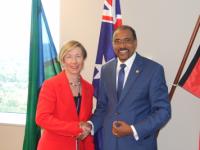 Jane Halton PSM, the Secretary of the Australian Department of Health and Ageing, and UNAIDS Executive Director Michel Sidibé in Canberra. Credit: Australian Department of Health and Ageing
Jane Halton PSM, the Secretary of the Australian Department of Health and Ageing, and UNAIDS Executive Director Michel Sidibé in Canberra. Credit: Australian Department of Health and AgeingIn Melbourne, the Executive Director delivered the keynote address at the 63rd UN DPI/NGO conference. UN Secretary-General Ban Ki-Moon opened the health-themed conference with a video message in which he underscored the many gains made in global health, including greater access to HIV treatment. But he cautioned delegates stating “We still have some distance to go. Meeting our commitments on health is central to meeting all of the Millennium Development Goals.”
Following the UN DPI/NGO conference – the largest UN event ever held in Australia – Mr. Sidibé joined the launch of the Michael Kirby Centre for Public Health and Human Rights. This new research centre, which focuses on the link between human rights and public health, is a collaborative venture between scientists, lawyers, medical practitioners and academics at the School of Public Health and Preventive Medicine at Monash University. Former Justice of the High Court of Australia, Michael Kirby is a renowned human rights expert and was recently appointed to the new Global Commission on HIV and the Law.
Also in Melbourne, Mr. Sidibé met with Australian business leaders at the Asia Pacific Business Coalition on AIDS (APBCA), which is leading the region's private sector response to HIV. He congratulated the business coalition for its engagement and encouraged even greater involvement of Australia’s dynamic private sector in delivering innovative solutions to respond to HIV across the region.
The Executive Director visited the HIV research laboratory of the Burnet Institute, Australia's largest virology and communicable disease research institute. Professor Sharon Lewin showcased the Institute’s cutting-edge research on low-cost laboratory diagnostic tools and the eradication of HIV reservoirs among people living with HIV.
Mr. Sidibé will conclude his Asia-Pacific tour in Japan where he will meet with Japanese Government officials and business leaders in Tokyo.
Right Hand Content
Multimedia:
Michel Sidibe’s speech at the Lowy Institute for International Policy (external link)
Feature stories:
UNAIDS Executive Director highlights Australia’s role in the Pacific AIDS response
(27 August 2010)
Papua New Guinea releases new HIV prevalence estimates (26 August 2010)
Government of Australia, UNAIDS sign partnership agreement (23 September 2009)
External links:
Lowy Institute for International Policy
Sydney Medically Supervised Injecting Centre
Ban hails role played by civil society in advancing global health
Australia's AID Program
The Asia Pacific Coalition on AIDS
Burnet Institute

Feature Story
Conference underscores young people’s leadership in HIV prevention
27 August 2010
27 August 2010 27 August 2010
Over five days, delegates from 112 countries—including 25 000 youth and representatives from government, civil society and the United Nations—shared ideas on young people’s involvement in achieving the Millennium Development Goals (MDGs).
The role of young people in improving the state of the world took centre stage at this week’s World Youth Conference in Leon, Mexico. Over five days, delegates from 112 countries—including 25 000 youth and representatives from government, civil society and the United Nations—shared ideas on young people’s involvement in achieving the Millennium Development Goals (MDGs).
With an estimated 40% of new HIV infections occurring among people aged 15-24, a youth-centered approach to the AIDS response will be critical to meet MDG 6—halting and reversing the spread of HIV—and to ensure efforts are sustained in the long term.
In a video message to young delegates, UNAIDS Executive Director Michel Sidibé said that young people had the power to shape a future with zero new infections, zero discrimination and zero AIDS-related deaths. “Each of you is a driving force for change and development in your own countries,” he said. “Together you are an incredible movement that is shaping the future of the world.”
Of the 33.4 million people living with HIV worldwide, some 5 million are young people. An estimated 2500 young people become newly infected with HIV each day. The epidemic has taken a particularly devastating toll on the lives of young women, who account for 66% of infections among youth worldwide.
Empowering young people to protect themselves from HIV represents one of UNAIDS’ ten priority areas, with the overall goal of a 30% reduction in new HIV infections by 2015.
At a joint workshop on HIV and young people, UNAIDS and UNFPA introduced a new “business case” outlining successes to date in the HIV response among youth and areas for improvement. Through the workshop, young delegates were invited to offer their perspectives on the relevance and application of the business case at the national level. Evidence-based information and HIV services, including sexual and reproductive health, were highlighted as critical to reducing infection among young people. Many participants voiced concern over reaching young people with effective HIV prevention messages.
“As we are still young and exploring, we may get into risky behaviors,” said Rodriguez Gastelum, a youth participant from Mexico who attended the workshop. “Correct information on HIV is the first step—that will protect us.”
Less than 40% of young men and women have access to accurate knowledge about HIV transmission—far short of the 95% target set in the UNGASS Declaration of Commitment for the year 2010. In developing countries, excluding China, only 30% of young men and 19% of young women benefit from comprehensive information on HIV.
Despite challenges, there are signs of progress. A new study from UNAIDS has reported a more than 25% drop in HIV prevalence among young people in 15 countries heavily affected by the AIDS epidemic.
“Simply put, young people are leading a prevention revolution all over the globe,” said Dr. César Nunez, Director of the UNAIDS Regional Support Team for Latin America, in a health-focused session at the conference. “The empowerment of young people has led to changes in sexual behavior. Young people are choosing to have sex later, with fewer partners, and they are using condoms.”
Earlier this month, the UN launched the International Year of Youth, an initiative designed to increase youth participation in global development issues and enhance inter-cultural dialogue and understanding across generations. At a launch event in New York City, UN Secretary-General Ban Ki-moon urged young people across the world to look beyond the borders of their own countries: “Engage with the world. Become a global citizen,” he said. “We are the leaders of today. You are the leaders of tomorrow.”
Right Hand Content
Cosponsors:
Press centre:
Joint statement by Heads of UN entities for the launch of the International Year of Youth
Multimedia:
View UNAIDS Executive Director’s video message (You Tube)
External links:
World Youth Conference 2010
International Year of Youth
Publications:
Young people business case for the UNAIDS priority area on young people
UNAIDS Outlook supplement: ‘Young people are leading the HIV prevention revolution’
Global guidance briefs on HIV and young people
Related

Feature Story
UNAIDS Executive Director highlights Australia’s role in the Pacific AIDS response
27 August 2010
27 August 2010 27 August 2010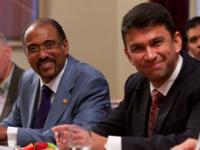
UNAIDS Executive Director Michel Sidibé (left) delivered a speech at the Lowy Institute for International Policy as part of its “Distinguished Speaker Series” and met with the Institute’s Executive Director, Dr. Michael Wesley (right). Credit: Lowy Institute
On the first day of a five day visit to Australia, the Executive Director of UNAIDS, Michel Sidibé, commended the country for its role as a key partner in the AIDS response in the Pacific region.
“Australia is helping us move the AIDS agenda forward in the Pacific region. The country understands the HIV epidemic’s regional dynamics,” said Mr. Sidibé. “For example I was just in Papua New Guinea and I saw how Australia’s commitment is bringing results.”
In 2008, Australia provided three-quarters of HIV assistance in the region. This included a US $38 million grant to Papua New Guinea, which is one of the most heavily affected countries by HIV in the region.
On day one of his visit, Mr. Sidibé delivered a speech at the Lowy Institute for International Policy as part of its “Distinguished Speaker Series”. He also met with the Institute’s Executive Director, Dr. Michael Wesley, and the Director of its HIV/AIDS project, Mr. Bill Bowtell.
“Mr. Sidibe’s visit helps us to recommit to the core principles of the Australian response to HIV – the strong partnership between all Australian governments, affected communities and clinicians and researchers to ensure the highest standards of care and treatment for people living with HIV and, above all, sustained prevention education activity directed at young people,” said Mr. Bowtell. “The Australian HIV/AIDS partnership greatly admires and supports Mr, Sidibé’s outstanding leadership and his support for much greater investment in effective HIV prevention activity nationally, regionally and internationally. We must continue to invest in these programmes”.
A recent UNAIDS and Zogby International poll finds that while AIDS may have faded from some countries’ headlines, it is a top health priority for Australians. The survey shows that 89% of Australians say AIDS is one of the most important issues facing the world today. However, only 41.5% felt that AIDS was a problem within their own country.
While Australia has a HIV prevalence of 0.2% among adults (aged 15-49), which is substantially lower than in several European countries and North America, there are groups more at risk of infection. Between 2004 and 2008, men who have sex with men made up 68% of newly diagnosed cases of HIV. Transmission during injecting drug use is responsible for a relatively modest share of new HIV infections, which is linked to the early adoption of evidence-informed harm reduction programmes.
One service that aims to continue to reduce HIV infection among drug users is Sydney’s Medically Supervised Injecting Centre. This pilot project first opened in May 2001 in the city’s Kings Cross district, where drug overdose deaths were concentrated. Mr. Sidibé visited the centre with its Director, Dr. Marianne Jauncey.
“I congratulate the New South Wales Government for this initiative which is a model for the region,” said Mr. Sidibé. “We have sound scientific evidence that shows providing a package of comprehensive harm reduction services to people who inject drugs prevents HIV infection.”
During his trip, Mr. Sidibé will attend the 63rd UN DPI/NGO conference in Melbourne as well as meet with government officials in Canberra.
Right Hand Content
Feature stories:
Papua New Guinea releases new HIV prevalence estimates (26 August 2010)
Government of Australia, UNAIDS sign partnership agreement (23 September 2009)
Multimedia:
Michel Sidibe’s speech at the Lowy Institute for International Policy (external link)
External links:
Lowy Institute for International Policy
Sydney Medically Supervised Injecting Centre

Feature Story
Papua New Guinea releases new HIV prevalence estimates
26 August 2010
26 August 2010 26 August 2010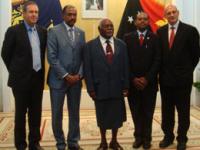
UNAIDS Executive Director Michel Sidibé (second from left) met with His Excellency the Governor General of PNG, Grand Chief, Sir Paulius Matane (middle) during his official visit to Papua New Guinea. 25-26 August 2010. Credit: Noreen Chambers
Approximately 0.92% of the adult population in Papua New Guinea was living with HIV in 2009, according to new estimates from the National Department of Health and the National AIDS Council Secretariat.
This latest round of estimates of HIV prevalence—carried out by a panel of national and international experts—is based on extensive data from antenatal clinics in Papua New Guinea’s Highlands, Southern, Momase, and New Guinea Islands regions.
In recent years, there has been a substantial increase in the number of health facilities in Papua New Guinea conducting HIV tests among pregnant women—from 17 in 2005 to 178 in 2009. New data collected at these facilities have provided a clearer picture of the country’s HIV prevalence than ever before.
“These new estimates have greatly enhanced our understanding of the scale and scope of Papua New Guinea’s AIDS epidemic,” said UNAIDS Executive Director Michel Sidibé, in an official visit to Papua New Guinea. “They provide an opportunity to redouble our efforts to achieve universal access to HIV prevention, treatment, care and support.”
An estimated 34 100 people in Papua New Guinea were living with HIV in 2009. HIV prevalence was found to be the highest in the country’s Highlands and Southern regions, at 1.02% and 1.17%, with lower but increasing prevalence in Momase and New Guinea Islands, at 0.63% and 0.61%. Approximately 3200 people in Papua New Guinea were newly infected with HIV in 2009 and, that same year, some 1300 people died of AIDS.
Papua New Guinea had previously projected a higher national HIV prevalence for the year 2009, based on data from a relatively small number of rural and urban sites. The downward revision in estimates reflects—to a large extent—improvements in national disease surveillance systems. The new findings also indicate that the spread of Papua New Guinea’s HIV epidemic may be levelling off.
“The risk factors that contribute to HIV infection in Papua New Guinea have not changed,” said Mr Sidibé. “We cannot afford to be complacent or reduce investments in the country’s AIDS response.”
Right Hand content
Feature Stories:
Christian faith leaders launch alliance to respond to AIDS in PNG(7 May 2010)
Papua New Guinea launch of the Commission on AIDS in the Pacific (11 March 2010)
Multimedia:
UNAIDS Executive Director talks to Radio Australia about Papua New Guinea’s HIV response

Feature Story
Young Olympians get the HIV message
23 August 2010
23 August 2010 23 August 2010
The Youth Olympic Games provide an opportunity to highlight the role of young people in promoting HIV prevention. Credit: UNAIDS
AIDS-inspired dance workshops, sports games with an HIV awareness-raising twist and make-your-own plasticine prevention messages were highlight activities coordinated by UNAIDS at the first-ever Youth Olympic Games, as part of the culture and education programme designed to encourage young Olympic athletes to learn more about issues of well-being, healthy lifestyle and social responsibility.
Throughout the proceedings of the Youth Games, held in Singapore from 14 to 26 August, a UNAIDS booth and a series of workshops addressed sexuality and HIV transmission, including myths and misconceptions, through interactive games, peer-to-peer discussion and innovative dance and drama methods.
Hosted in the Olympic village, the activities were accessible to the 3600 participating young athletes aged 14-18 and 1400 team officials. Every day, hundreds of young athletes visited the UNAIDS booth and workshops, with all activities coordinated and delivered by volunteers from UNAIDS event partners Y-PEER from the Philippines, Singapore-based organization BEADS as well as Youth Olympic Games volunteers.
“Despite language barriers, we were able to unite and channel energies of athletes coming from different cultures and backgrounds to talk about HIV and reiterate the need for protection and awareness,” said Y-PEER volunteer Mario Balibago.
While visiting the UNAIDS booth, athletes were encouraged to post updates to the UNAIDS Facebook page. “HIV is a good thing to talk about with the youth and to share… all over the world. Protect yourself and show love for people with HIV,” posted Kernesha Spann, a young 400m runner from Trinidad and Tobago.
The UNAIDS booth also received a number of high-profile visitors including Mr Jacques Rogge, President of the International Olympic Committee, and Mr Wilfried Lemke, the UN Secretary-General’s Special Advisor on Sport and Development, who both commended the use of innovative formats to reach young people with HIV messages through sport.
The partnership with the Youth Olympic Games is geared towards emphasizing UNAIDS’ priority area of empowering young people to protect themselves against HIV and as part of activities in support of the International Year of Youth, which commenced on 12 August. Following the successful interventions in Singapore, UNAIDS will continue to work with the International Olympic Committee to strengthen the partnership, including exploring the development of a cadre of Youth Athlete Champions for HIV.
“Sport is an incredible channel for getting HIV messages out to young people. As well as the athletes, the volunteers working with us at the booth also became hugely sensitized on HIV issues and wanted to spread the word further,” said Dawn Foderingham, Partnerships Advisor at the UNAIDS Regional Support Team for Asia and the Pacific who coordinated UNAIDS’ participation in the Youth Games. “Young people are champions both on and off the field and their leadership on HIV can have critical impact,” she added.
Right Hand Content
Partners:
International Olympic Committee
Feature stories:
Inaugural Youth Olympic Games in Singapore (13 August 2010)
(UN News) UN official calls on young Olympians to help improve their home communities
External links:
International Year of Youth web site
Singapore 2010 Youth Olympic Games
Publications:
2010 Outlook Report supplement: Young people are leading the HIV prevention revolution
Together for HIV & AIDS prevention: a toolkit for the sports community

Feature Story
AIDS a key issue for international youth dialogue
20 August 2010
20 August 2010 20 August 2010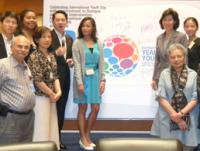
Asia-Pacific Year of Youth launch roundtable panel. Credit: UNAIDS
HIV and sexual and reproductive health has been identified as a central theme for discussion as part of the International Year of Youth, a United Nations (UN)-led initiative launched this month by the Secretary General Ban Ki-moon.
Under the overarching theme of “dialogue and mutual understanding,” the Year of Youth aims to promote peace, respect for human rights and solidarity across generations through activities that highlight issues of increasing importance for youth—including HIV, the environment, hunger and employment. Young people are encouraged to participate in local and global efforts to achieve internationally-agreed targets, such as the Millennium Development Goals.
With young people aged 15-24 accounting for 40% of all new HIV infections, increased youth engagement in the AIDS response is critical. Empowering young people to protect themselves from HIV is one of ten UNAIDS priority areas, with the overall goal of a 30% reduction in new HIV infections by 2015. UNAIDS has committed to achieving three ‘bold results’ in at least nine of the 17 high-burden countries. These include:
- ensuring at least 80% of young people in and out of school have comprehensive knowledge of HIV;
- doubling young people’s use of condoms;
- doubling young people’s use of HIV testing and counselling services.
Youth in Asia-Pacific call for open dialogue on HIV

UNAIDS National Goodwill Ambassador for China, CCTV presenter and moderator of the Asia-Pacific Year of Youth launch James Chau listens to interventions from young people. Credit: UNAIDS
At the Asia-Pacific launch of the Year of Youth in Bangkok, Thailand, young people from across the region underlined limited access to sex education and HIV-related information as key areas of concern. During the launch event—a roundtable dialogue between youth representatives, heads of UN agencies and government officials, moderated by UNAIDS Goodwill Ambassador for China and television presenter James Chau—young participants highlighted the need for parents and others to “get outside their comfort zones” in order to better reach youth with information on sex and HIV.
“My parents have talked to me openly about sex and HIV for as long as I can remember,” said Benya, a 14-year-old high school student from Bangkok. “I think this helps me make good choices in my life.”
Young participants emphasized that greater access to evidence-based information on HIV and sexual and reproductive health, through both traditional and new media channels, was critical for youth empowerment on HIV-related issues.
Steve Kraus, Director of the UNAIDS Regional Support Team for Asia and the Pacific, underscored that evidence shows that when young people are given accurate information about sex and HIV, they choose to have sex later, with fewer partners and increased use of condoms.
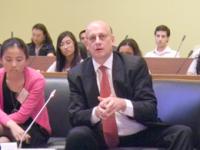
Steve Kraus, Director of the UNAIDS Regional Support Team, underlines that young people are “leading the prevention revolution.” Credit: UNAIDS
“Young people are leading the prevention revolution. Recent data show that HIV prevalence has dropped by 25% among youth in 15 of the highest-burden countries. We have to continue this momentum,” said Mr Kraus. “The International Year of Youth provides a key opportunity for us to massively increase our emphasis on bringing young people to the table and ensuring their voices are heard in the important debates on HIV.”
For the Asia-Pacific region—and across the world—the Year of Youth launches will be followed by a series of targeted activities to showcase youth contributions to development, encourage dialogue and highlight the benefits and significance of youth participation in all aspects of society.

Feature Story
Inaugural Youth Olympic Games in Singapore
13 August 2010
13 August 2010 13 August 2010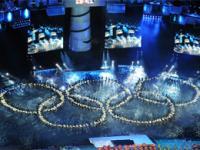
Opening ceremony of the Youth Olympic Games, Singapore, 14 August 2010. Credit: SPH-SYOGOC/Alphonsus Chern
During the next two weeks, Singapore is making Olympic history by being the host of the first-ever Youth Olympic Games, opening on 14 August 2010.
The Youth Olympic Games, to be held every two years (alternating Summer and Winter), is an international high-level sporting event for young people, which offers a balance of sport, culture and education. The Games were created to educate, engage, and influence young athletes, inspiring them to play an active role in their communities.
Around 370,000 spectators will gather to watch young athletes, aged 14 to 18 from around the world, participate in Singapore 2010. The inaugural games include high-level competition in 26 sports categories and a Cultural and Education Programme focused on a variety of themes including the Olympic values. It will also consist of skills-building sessions for participants, including on HIV.
Young athletes are role models in their communities. We need to call on these young people to lead the prevention revolution if we are to reach UNAIDS vision of Zero new infections
Mr Michel Sidibé, UNAIDS Executive Director
As young people account for 40% of all new HIV infections globally, placing young people in the driving seat to halt and to begin to reverse the HIV epidemic is crucial.
“Young athletes are role models in their communities. We need to call on these young people to lead the prevention revolution if we are to reach UNAIDS vision of Zero new infections,” said Mr Michel Sidibé, UNAIDS Executive Director, “Sports can be a powerful vehicle to come about change in societies around the world.”
UNAIDS has partnered with the Singapore Youth Olympic Games Organising Committee (SYOGOC) in the context of its overall partnership with the International Olympic Committee (IOC) in order to provide HIV prevention information and raise awareness about HIV among young people during the two weeks of the Games.
 Credit: IOC
Credit: IOC“HIV awareness and prevention campaigns are most effective when addressed to the youth” said Mr Jacques Rogge, President of the International Olympic Committee. He added: “Sport is a powerful tool for reaching out to today’s youth on all continents and for educating them early on about healthy and responsible behaviours.”
UNAIDS, together with civil society organizations, will conduct a series of workshops focusing on adolescent sexual and reproductive health as well as stigma surrounding HIV under the educational theme “Well-Being and Healthy Lifestyle.” Workshops will be open to the estimated 3,600 young, athletes and 1,400 officials in the Olympic Village.
The workshops will be run in collaboration with Y-PEER, a youth-to-youth initiative, and BEADS, a Singapore organization. The sessions will use dance and competitive games to address topic such as sexuality and HIV transmission, and addressing myths and misconceptions about HIV.
Sport is a powerful tool for reaching out to today's youth on all continents and for educating them early on about healthy and responsible behaviours.
Mr Jacques Rogge, President of the International Olympic Committee
The content of these interactive sessions has been developed specifically for the Youth Olympic Games to engage athletes. In addition, condoms have been made available for free at the medical clinics.
Sport is recognized as a powerful communication tool and is unique in its ability to unify and galvanize people all over the world. In recognizing the importance of sports for development, the partnership with the Youth Olympic Games is geared towards one of UNAIDS’ ten priority areas namely to empower young people to protect themselves against HIV.

Feature Story
Michel Sidibé meets Chinese leaders, highlights barriers to MDG achievement
12 August 2010
12 August 2010 12 August 2010
Chinese Vice President Xi Jinping (R) meets with Michel Sidibé (L), executive director of UNAIDS in Beijing, 11 August 2010. Credit: Xinhua/Pang Xinglei
UNAIDS Executive Director Michel Sidibé met with top Chinese government leaders yesterday in Beijing to discuss China’s AIDS response. In meetings with Vice President Xi Jinping and Vice Minister of Health, Yin Li, Mr Sidibé commended China for its strong political commitment to the AIDS response, and outlined workable recommendations to strengthen China’s AIDS response.
In discussions with Vice President Xi Jinping, Mr Sidibé noted that China’s achievements in recent decades with regard to poverty reduction, expanding access to education, and reducing mortality and extending life expectancy have been truly astonishing. “China’s progress has strongly demonstrated the commitment of the Chinese government to delivering on human development and its MDG commitments,” said Mr Sidibé. “However, there is still work to be done, and significant scaling-up of quality HIV treatment and prevention efforts will be necessary if MDG 6 (halting and reversing the HIV epidemic) is to be achieved in China.”
There is still work to be done, and significant scaling-up of quality HIV treatment and prevention efforts will be necessary if MDG 6 (halting and reversing the HIV epidemic) is to be achieved in China.
Michel Sidibé, Executive Director of UNAIDS
Mr Sidibé urged the Chinese government to set targets to halve HIV infections and deaths from AIDS by 2015, in order to meet and exceed MDG 6, and halt and reverse China’s HIV epidemic.
During their meeting at the Great Hall of the People on Wednesday, Vice President Xi said, “the Chinese government attached great importance to the prevention of HIV, which has become the country's leading infectious disease killer. With increased funding for anti-AIDS programs, China has implemented prevention, treatment and care policies to secure the rights and interests of people living with HIV.”
China has implemented prevention, treatment and care policies to secure the rights and interests of people living with HIV
China Vice President Xi Jinping
During the meeting Mr Xi also vowed to support appeals from the United Nations and the international community to bolster south-south cooperation with Africa and push for the realization of Millennium Development Goals worldwide.
While in Beijing, Mr Sidibé also took the opportunity to present awards to Vice Minister Yin Li and Mr Li Jingwu of the Law Office of China’s State Council, in recognition of their considerable commitment and contribution to China’s AIDS response.
Right Hand Content
Feature stories:
Engaging cities in the HIV response (10 August 2010)
Multimedia:
Watch CCTV Interview with Michel Sidibé (Begins at 20 minutes)

